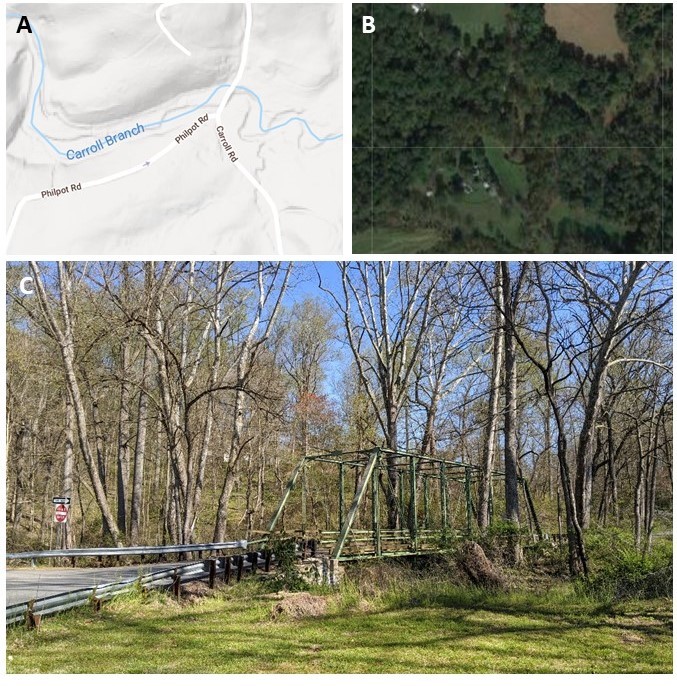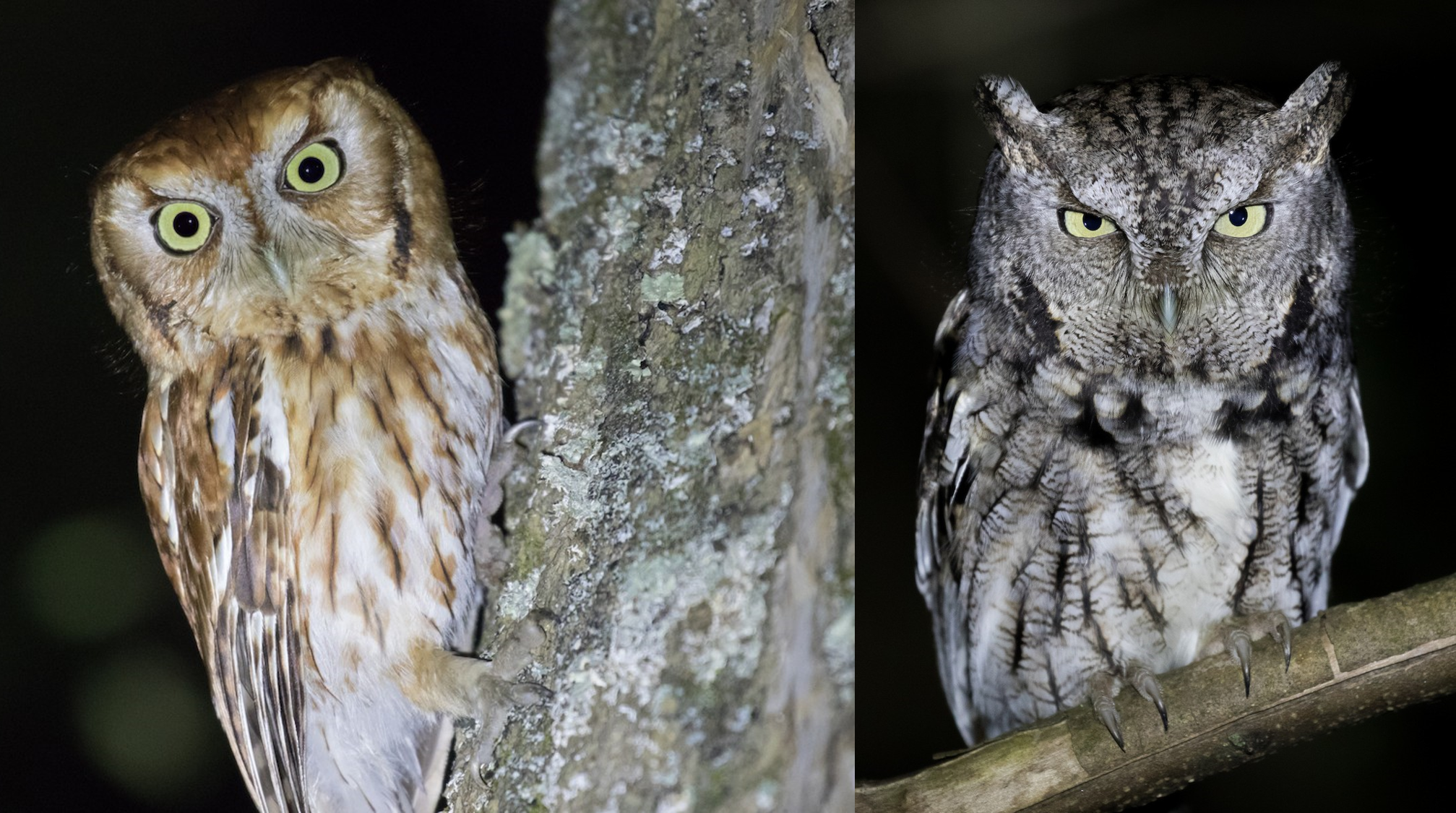The world is a big place, and the idea of venturing out at night to find owls is an intimidating proposition. There are many reasons that owling is one of the least practiced forms of birding, but one of the highest on the list has to be the sense that it is difficult, with a low chance of success. Owls are hard to find! Why stay up late, or wake up early, only to walk around in the dark and cold while hoping to stumble across an owl?
I certainly felt that way myself, but since I had adopted some Baltimore blocks for the Maryland & DC Breeding Bird Atlas 3, I resolved to at least give it a try. And I’m happy to report that owling is a tremendously rewarding addition to the birding experience, with a completely unique perspective on these rarely-seen nocturnal species.
Of the three main breeding species of owls in Maryland, Eastern Screech-Owls are the least commonly reported. Many birders have heard or seen Barred Owls in the daytime and the call of the Great Horned Owl carries for long distances, so these species were coded more frequently than Eastern Screech-Owls. Eastern Screech-Owls are small, with a quiet call and rarely seen in daylight. But it turns out they are very easy to find at night! In just a few months, I have identified over twenty-five Eastern Screech-Owls locations in Baltimore County and continue to add more every night I go out.
As with every species, owls are particular about their habitat, and looking in the correct spots will maximize chances of success. In my experience, Eastern Screech-Owls are rarely found far from water, and the most reliable locations are forested stream crossings. Here is my step-by-step owling process:
1) Identify potential locations – using Google maps you can toggle between ‘Terrain’ and ‘Satellite’ views while looking for bridge crossings over small streams with a patch of forest around them (Figure 1a, Figure 1b). Open fields or even residential housing nearby are no problem, and may be preferable to nothing but mature forest.

Figure 1. Examples of screech-owl habitat, prime for atlasing. Photo credit: Simon Best
2) Daytime scouting – this will confirm the suitability of the location, with a mix of mature trees, undergrowth, and open fields (Figure 1c). If you can hear running water, that is a great sign! Daytime scouting also helps identify parking pull-offs, which are common around bridges.
3) Equipment – a Bluetooth speaker that can sync to your phone and a bright flashlight are both essential. I use a Fenix 860 Lumen flashlight with high-quality rechargeable batteries. This gives off enough light that a flash is not required for photography.
4) Get out at dark – the most important factor is wind, far more than moonlight or clouds, or dusk, night, or dawn. Screech-owl calls are quiet and don’t carry well, so if you choose a night with minimal wind you’ll be in a much better position to hear the owl when it starts calling.
5) Play the recording – while playing calls during the breeding season is discouraged for diurnal species, playing a recording at night for atlasing purposes is part of the recommended protocol. The cadence of screech-owl calling is quite rapid, and I play the alternating ‘trill’ and ‘whinny’ call with only about a 20 second gap between them.
6) Location – there is no need to hike into the woods. In fact, the best place to play the recording is directly on the bridge or stream edge. The photos in Figure 2 were taken within 20 feet of my car, from pavement. They will come to you!
7) Response – the fastest I have seen a screech-owl after parking the car is probably 90 seconds, while the longest is about 10 minutes. In general, you will start to hear the trilling almost so quietly you think you are hearing a phantom noise, and then more loudly as they come closer. Owls fly silently, but they sometimes make a noise upon landing, like a rustling branch, or the tink of their claws on a nearby metal post. On moonlit nights, the shadow of the incoming bird can occasionally be seen, and I’ve even had the owl buzz by my head! They will continue to come closer even when the tape has been stopped, and often incredibly close if they find a suitable perch from which to trill.

Figure 2. On the right is a red-phase screech-owl compared to a gray-phase screech-owl on the left. Photo credit: Simon Best
8) Locating the owl – I was surprised to discover how low to the ground screech-owls can be. Certainly there are times when they are overhead, but the vast majority of the time they perch at eye-level or even lower. Many times they find a branch not more than a foot or two off the ground! After being located with a light, screech-owls continue to behave comfortably, trilling even as you move around for a better view or for a photograph. Seeing the owl rather than just hearing it also allows you to appreciate the red and gray color morphs of the Eastern Screech-owl (Figure 2). Most of my encounters end with me turning off the light and walking away out of respect, not because the owl has flushed or flown away. Sometimes I will drive away with the owl still calling from the same perch! They appear completely nonplussed by my presence at night.
9) Other owls – playing screech-owl tapes will sometimes draw in another species, particularly hungry Barred Owls. But I have never had a location with both species, and it seems to me that they have sorted out their territories long before I arrive. If a location seems promising for screech-owls but there is no response after ten minutes, it is always worth playing a Barred Owl recording. Regardless of whether they are responding to a screech-owl or Barred Owl recording, Barred Owls will fly in and remain silent—essentially the opposite of screech-owls. Barred Owls will perch much higher up in the trees, usually on a strong horizontal branch.
Finding an owl at night is a thrilling experience. These beautiful birds appear out of the darkness, and being around them at night is a brief window into their world. The fact that we can do this while contributing valuable data to the Maryland & DC Breeding Bird Atlas makes it even better!



